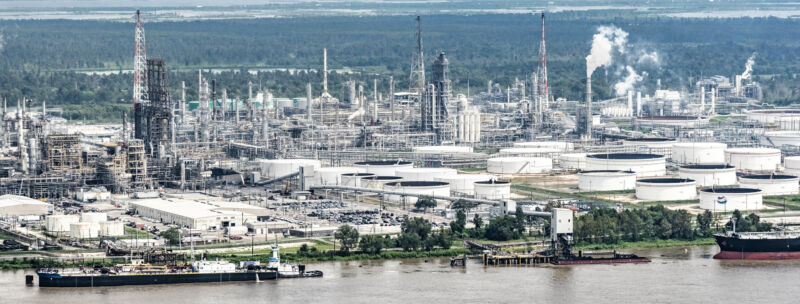Out of the air —
Chemical plants will have to monitor how much is escaping and stop leaks.

Enlarge / An oil refinery in Louisiana. Facilities such as this have led to a proliferation of petrochemical plants in the area.
On Tuesday, the US Environmental Protection Agency announced new rules that are intended to cut emissions of two chemicals that have been linked to elevated incidence of cancer: ethylene oxide and chloroprene. While production and use of these chemicals takes place in a variety of locations, they’re particularly associated with an area of petrochemical production in Louisiana that has become known as “Cancer Alley.”
The new regulations would require chemical manufacturers to monitor the emissions at their facilities and take steps to repair any problems that result in elevated emissions. Despite extensive evidence linking these chemicals to elevated risk of cancer, industry groups are signaling their opposition to these regulations, and the EPA has seen two previous attempts at regulation set aside by courts.
Dangerous stuff
The two chemicals at issue are primarily used as intermediates in the manufacture of common products. Chloroprene, for example, is used for the production of neoprene, a synthetic rubber-like substance that’s probably familiar from products like insulated sleeves and wetsuits. It’s a four-carbon chain with two double-bonds that allow for polymerization and an attached chlorine that alters its chemical properties.
According to the National Cancer Institute (NCI), chloroprene “is a mutagen and carcinogen in animals and is reasonably anticipated to be a human carcinogen.” Given that cancers are driven by DNA damage, any mutagen would be “reasonably anticipated” to drive the development of cancer. Beyond that, it appears to be pretty nasty stuff, with the NCI noting that “exposure to this substance causes damage to the skin, lungs, CNS, kidneys, liver and depression of the immune system.”
The NCI’s take on Ethylene Oxide is even more definitive, with the Institute placing it on its list of cancer-causing substances. The chemical is very simple, with two carbons that are linked to each other directly, and also linked via an oxygen atom, which makes the molecule look a bit like a triangle. This configuration allows the molecule to participate in a broad range of reactions that break one of the oxygen bonds, making it useful in the production of a huge range of chemicals. Its reactivity also makes it useful for sterilizing items such as medical equipment.
Its sterilization function works through causing damage to DNA, which again makes it prone to causing cancers.
In addition to these two chemicals, the EPA’s new regulations will target a number of additional airborne pollutants, including benzene, 1,3-butadiene, ethylene dichloride, and vinyl chloride, all of which have similar entries at the NCI.
Despite the extensive record linking these chemicals to cancer, The New York Times quotes the US Chamber of Commerce, a pro-industry group, as saying that “EPA should not move forward with this rule-making based on the current record because there remains significant scientific uncertainty.”
A history of exposure
The petrochemical industry is the main source of these chemicals, so their release is associated with areas where the oil and gas industry has a major presence; the EPA notes that the regulations will target sources in Delaware, New Jersey, and the Ohio River Valley. But the primary focus will be on chemical plants in Texas and Louisiana. These include the area that has picked up the moniker Cancer Alley due to a high incidence of the disease in a stretch along the Mississippi River with a large concentration of chemical plants.
As is the case with many examples of chemical pollution, the residents of Cancer Alley are largely poor and belong to minority groups. As a result, the EPA had initially attempted to regulate the emissions under a civil rights provision of the Clean Air Act, but that has been bogged down due to lawsuits.
The new regulations simply set limits on permissible levels of release at what’s termed the “fencelines” of the facilities where these chemicals are made, used, or handled. If levels exceed an annual limit, the owners and operators “must find the source of the pollution and make repairs.” This gets rid of previous exemptions for equipment startup, shutdown, and malfunctions; those exemptions had been held to violate the Clean Air Act in a separate lawsuit.
The EPA estimates that the sites subject to regulation will see their collective emissions of these chemicals drop by nearly 80 percent, which works out to be 54 tons of ethylene oxide, 14 tons of chloroprene, and over 6,000 tons of the other pollutants. That in turn will reduce the cancer risk from these toxins by 96 percent among those subjected to elevated exposures. Collectively, the chemicals subject to these regulations also contribute to smog, so these reductions will have an additional health impact by reducing its levels as well.
While the EPA says that “these emission reductions will yield significant reductions in lifetime cancer risk attributable to these air pollutants,” it was unable to come up with an estimate of the financial benefits that will result from that reduction. By contrast, it estimates that the cost of compliance will end up being approximately $150 million annually. “Most of the facilities covered by the final rule are owned by large corporations,” the EPA notes. “The cost of implementing the final rule is less than one percent of their annual national sales.”
This sort of cost-benefit analysis is a required step during the formulation of Clean Air Act regulations, so it’s worth taking a step back and considering what’s at stake here: the EPA is basically saying that companies that work with significant amounts of carcinogens need to take stronger steps to make sure that they don’t use the air people breathe as a dumping ground for them.
Unsurprisingly, The New York Times quotes a neoprene manufacturer that the EPA is currently suing over its chloroprene emissions as claiming the new regulations are “draconian.”